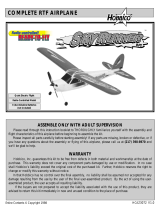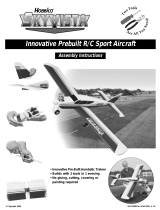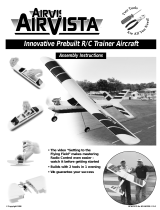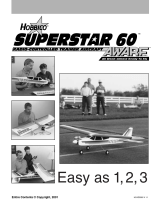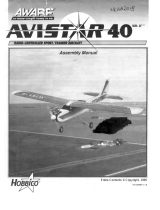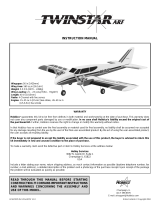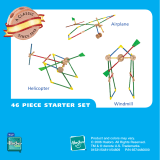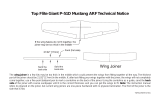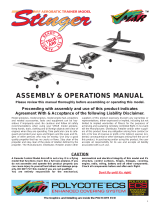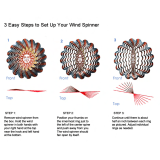Page is loading ...

© Copyright 1997
HCAZ3091 for HCAA2075 V 1.0
ASSEMBLY INSTRUCTIONS
™
90-Day Limited Warranty
If you, as the original owner of this model, discover defects in parts or
workmanship within 90 days of purchase, Hobbico will repair or replace it –
at the option of
our authorized U.S. repair facility, Hobby Services – without charge. Our liability does not include cost of shipping to us. However, Hobby Services will pay
shipping expenses to return your model to you. You must provide proof of purchase, such as your original purchase invoice or receipt, for your model’s warranty
to be honored. This warranty does not apply to damage or defects caused by misuse or improper assembly, service or shipment. Modifications, alterations or
repair by anyone other than Hobby Services voids this warranty. We are sorry, but we cannot be responsible for crash damage and/or resulting loss of kits,
engines, accessories, etc.
Repair Service
Your Twinstar must be returned directly to Hobby Services for warranty work. The address is: Hobby Services, Attn: Service Department, 1610 Interstate
Drive, Champaign, IL 61821-1067 Phone: (217) 398-0007. Please follow the instructions below when returning your model. This will help our experienced
technicians to repair and return it as quickly as possible.
1. ALWAYS return your entire system, including airplane and radio.
2. Disconnect the receiver battery switch harness and make sure that the transmitter is turned off. Disconnect all batteries and drain all fuel.
3. Include a list of all items returned and a THOROUGH, written explanation of the problem and service needed. If you expect the repair to be covered under
warranty, also include your proof of purchase.
4. Include your full return address and a phone number where you can be reached during the day.
If your model is past the 90-day warranty period or is excluded from warranty coverage, you can still receive repair service through Hobby Services at a
nominal cost. Repair charges and postage may be prepaid or billed COD. Additional postage charges will be applied for non-warranty returns. All repairs
shipped outside the United States must be prepaid in U.S. funds only. All pictures, descriptions and specifications found in this instruction manual and on the
product package are subject to change without notice. Hobbico maintains no responsibility for inadvertent errors.

Take a moment now to
match the box contents
with the items listed
below. Following the
Twinstar assembly
instructions will be
quite easy if you
identify
and organize the parts
before you begin.
Replacement Parts Available
HCAA3690...Wing Kit HCAA3694....Landing Gear Set
HCAA3691...Fuselage Kit HCAA3695....Nacelle Set (L&R)
HCAA3692...Fin Set HCAA3696....Nacelle Cover
HCAA3693...Spinner HCAA3697....
Nose Cone (2 pcs.)
2
Landing Gear
Part # Quantity
15 Main Landing Gear....................2
5 Nose Gear.................................1
4 Steering Arm .............................1
14 Wheels ......................................3
66 Wheel Collars............................5
67 3 x 8mm Screw .........................1
68 3 x 5mm Screw .........................5
Wing Assembly
Part # Quantity
6 Dihedral Brace.........................................3
7 Right Wing Panel.....................................1
8 Left Wing Panel........................................1
28 *Clevises..................................................2
40 4mm Washers..........................................2
41 4 x 35mm Bolt..........................................2
42 4mm O-ring..............................................2
43 Engine Nacelle (R)...................................1
44 Engine Nacelle (L) ...................................1
45 Wing Bolt Plate ........................................1
46 Servo Tray (Wing)....................................3
47 *Aileron Control Horns.............................2
50 Fuel Tank Brace.......................................2
61 Front Root Ribs........................................2
62 Rear Root Ribs ........................................2
40
42
47
28
46
45
39
You’re about to build in just hours what took aviation
pioneers years—a powered machine that flies. Specially
created for you and other experienced radio control
modelers, Hobbico’s Twinstar offers nearly all the
excitement of piloting a real airplane...and develops skills
that will take you anywhere you want in your hobby.
41
*Parts marked with an asterisk are found on the plastic parts tree.
Know Your Model’s Parts
Tail Assembly
Part # Quantity
1 Stabilizer and Elevator ..................1
16 Rudder and Fin..............................1
28 *Clevises.......................................5
29 *Control Horns...............................2
31 2mm x 18 mm Machine Screws....4
53 Dorsal Fin......................................1
53 Dorsal Fin Decal............................1
30
28
31
29

Fuse Parts
Part # Quantity
2 Stab Base..........................................1
9 Nacelle Covers ..................................2
12 Spinners ............................................2
17 Servo Tray (Fuse)..............................1
27 Fuselage............................................1
48 Nose Decals (R) ................................1
49 Nose Decals (L).................................1
51 Nose Cone (R)...................................1
52 Nose Cone (L) ...................................1
63 Vertical Front Brace...........................2
64 Horizontal Front Brace.......................1
Fuel Tank & Parts
• Parts Shown Below
Part # Quantity
19 Fuel Tank...........................................2
20 Rubber Tank Stopper.........................2
21 Fuel Pick-up Weight (Clunk) ..............2
22 Plastic Stopper Compression Disks
(One Large and One Small)...............4
23 Aluminum Fuel Tubing
(One Short and One Long).................4
24 3 x 18mm Screw ................................2
25 Silicone Fuel Line...............................2
26 Foam Tank Collar...............................2
3
23
21
25
24
20
22
26
7
9
9
6
14
27
14
15
19
44
49
50
50
48
52
51
64
63
64
43
19
17
12
46
16
15
53
14
11
11
36
37
Plastic
Parts
Tree
8
5
4
12
1
2
Parts shown smaller than actual size (out of proportion).
Engine Mounting Parts
Part # Quantity
11 Engine Mount ....................................2
36 Pushrods ..........................................2
37 Pushrod Wire.....................................2
65 Pushrod Tubes ..................................2

Getting Ready for Flight
1. While building your Twinstar, make sure to follow the instructions. Do not alter or modify the model, as doing so may result in an unsafe or
unflyable model. In a few cases the instructions differ slightly from the photos. In those instances the instructions are correct.
2. You must install all components so the model operates on the ground as well as in the air.
3. You must check the operation of the model before EVERY flight to ensure all equipment is operating, and the model has remained structurally
sound. Be sure to check the clevises and other connectors often and replace them if they show signs of wear or fatigue
4. When you are preparing to go and fly your model, make sure to fully charge the radio system according to the manufacturer’s instructions the
night before. Fully prepare your field box, making sure you have the necessary items for starting your engines. Remember to take along spare
propellers and glow plugs, as well as some epoxy and CA glue, just in case. Being prepared at the field will make your flying experience much
more enjoyable.
Other Items You’ll Need:
Glues
Choose 6-minute and 30-minute epoxy, such as Great Planes
®
Pro
TM
Epoxy, which has been formulated especially for R/C model
building. Pro Epoxies offer a strong bond and a variety of curing
times suited for every step of assembly. You’ll also need a thin
instant-setting CA (cyanoacrylate), a thicker CA+, plus rubbing
alcohol for easy epoxy cleanup.
Model Engine
Power your Twinstar with two high-quality, .25
to.32-size model engines. The O.S
®
. .25 FP, or
O.S. .32 F are fine engines for this plane. Look for
features such as easy break-in, easy starting,
efficient carburetion and low maintenance. Check
the manufacturer’s recommendations for
propellers to use with your engine.
Radio Equipment
In selecting a radio system for your Twinstar, you’ll need at least a
4-channel radio system with five standard servos. Many of the
4-channel radios offered include only three servos, so it may be
necessary to purchase two extra servos along with your radio
system. Unless you are planning to use a computer radio and mix
the throttle servos, you will also need a “Y” harness for your
Twinstar. The servos and receiver will be mounted on-board your
model and need to be cushioned from shock and vibration. One-
half inch thick foam rubber sheets (HCAQ1050) are available from
your hobby dealer for this purpose
.
Hardware
Tools and accessories required for
assembly include a hobby knife; small and
large Phillips screwdrivers; needle nose
pliers; drill with 1/16", 1/8", 3/32" 3/16",
5/32" and 5/64" bits; ruler; 2 feet of medium
fuel tubing; and 150 to 200-grit sandpaper.
Other General Items Required
Epoxy Brushes (GPMR8062) Mixing Sticks (GPMR8055) Clothespins 1/4" Foam Rubber (HCAQ1050)
T-Pins (HCAR5150) Masking Tape String Felt-Tip Pen
Sanding Block Adjustable Wrench Paper Towels Builders Triangle Set (HCAR0480)
Plastic Wrap or Wax Paper Round Toothpicks Wire Cutter Thread Locking Compound
70% Isopropyl Alcohol Small Hobby Clamps Razor Saw
4

Your Hobbico Twinstar is not a toy, but
rather a sophisticated, working model that
functions very much like an actual airplane.
Because of its realistic performance, the
Twinstar, if not assembled and operated
correctly, could possibly cause injury to
yourself or spectators and damage
property.
If this is your first low wing sport
model, or if you are uncomfortable in
making the initial flight of your
Twinstar, it is recommended that you
get help from an experienced,
knowledgeable modeler with your
initial flights.
You may also want to contact the
Academy of Model Aeronautics (AMA),
which has more than 2,500 chartered
clubs across the country. Through the
AMA, you should either be able to locate a
modeler nearby that can help, or at least
be able to phone one that can verbally
instruct you for any potential problems that
could occur. Contact the AMA at
the
address or phone number
below:
Academy of Model Aeronautics
5151 East Memorial Drive
Muncie, IN 47302
Office: (765) 287-1256
Toll Free: (800) 435-9262
Fax: (765) 741-0057
Protect Your Model, Yourself & Others...
Follow This Important Safety Precaution
WARNING! This is not a Toy!
Please follow these safety precautions:
Before you fly:
1.Make sure that no other fliers are using your radio
frequency.
2.Your radio transmitter must be the FIRST thing you
turn ON, and the LAST thing you turn OFF.
3.Double check all control surfaces.
4.Make sure that the transmitter & receiver batteries
are fully charged.
Fuel storage and care:
1.Do not smoke near your engine or fuel.
2.Store all engine fuel in a safe, cool, dry place, away
from children and pets. Model fuel will evaporate, so
make sure that you always store it with the
cap secure.
When starting and running your engine:
1.Always wear safety glasses.
2.Make certain that your glow plug clip is securely
attached to the glow plug and cannot pop off,
possibly falling into the spinning propeller.
3.Use a “chicken stick” or electric starter to start the
engine – NOT your fingers.
4.Make sure that the wires from your starter and glow
plug clip cannot become tangled with the spinning
propeller.
5.Do not stand at the side of the propeller when you
start or run the engine. Even at idle speed, the
spinning propeller will be nearly invisible.
6.If any engine adjustments are necessary, approach
the engine only from behind the spinning propeller.
5
JOIN THE AMA

6
Special Note:
You should charge your radio system before starting to
build. Following the manufacturer’s directions, connect
your transmitter and receiver batteries to the system’s
charger.This way the radio will be ready when it is time
to install the radio components.
Prepare the Wing Joiners:
❏ 1. Locate the 1/8" (3mm) die-cut plywood wing
joiners
and separate the three individual joiners from the die-
cut plywood sheet using a hobby knife. Arrange the
three “V"-shaped joiners in the same orientation as they
will be glued together.
Glue the Wing Joiners:
Note: Please read steps 2 through 4 before gluing.
❏
2. Mix approximately 1/4 oz. (7.5ml) of 30-minute
epoxy. Using a mixing stick or epoxy brush, apply an
even coat of epoxy on both sides of one of the wing
joiners. Sandwich this coated joiner between the
remaining two joiners. Quickly proceed through the
following steps (3 and 4) before the epoxy cures.
Remove the Excess Epoxy:
❏
3. Excess epoxy will squeeze out of the seams
between the joiners and must be removed before the
epoxy is allowed to cure. Use a paper towel dampened
with rubbing alcohol to remove any excess epoxy.
Clamp the Wing Joiner:
❏
4. Use clothespins to clamp the wing joiners firmly
together. If any more epoxy squeezes out, remove it
using a paper towel. Make sure that the joiners are
evenly lined up with each other.
Mark the Centerline on the Joiner:
❏
5. After the epoxy has cured and the clothespins
have been removed, draw a centerline on both sides of
the plywood wing joiner.
Wing Joiner Assembly

Even the Edges:
❏
6. Using a flat sanding block or similar tool, lightly
sand the wing roots to remove any irregularities. Do not
sand off too much as the dihedral angle could be
altered.
Install the Front Root Ribs:
❏
7. Locate the two 1/8" (3mm) front root ribs. Position
the rib so the tab is on the top of the wing. The aileron
torque rod is also located on the top of the wing, which
can be used as a reference. Align the rear edge of the
rib flush with the front edge of the joiner pocket. It
should also follow the contour of the bottom of the wing.
Use 1/4 oz. (7.5ml) of 6-minute epoxy to glue the rib in
position. Use masking tape to hold the rib securely to
the wing until the epoxy has fully cured.
Install the Rear Root Ribs:
❏
8. Locate the two 1/8" (3mm) rear root ribs. Position
the rib with the front edge flush with the aft edge of the
joiner pocket. The rib should follow the contour of the
wing airfoil when positioned correctly. Once satisfied
with the fit, use 6-minute epoxy to attach the rib to the
wing. Use masking tape to hold the rib securely to the
wing until the epoxy has fully cured.
Mark the Wing Joiner Pocket:
❏
9. Lay the wing halves on the work surface with the
aileron torque rods facing upwards. Place a mark at the
aft edge of the wing joiner pocket using a felt-tip pen.
This line will aid in positioning the aileron servo tray.
Position the Aileron Servo Tray:
❏
10. Locate one of the 1/8" (3mm) plywood servo
trays. Position the servo tray so the front edge rests at
the line drawn locating the aft edge of the joiner pocket.
Using a felt-tip marker, mark the position for the front
and rear of the opening in the servo tray.
Mark the Aileron Servo Location:
❏
11.Measure in 3/8" (10mm) from the edge of the root
ribs and draw a line connecting the front and rear lines
7

8
drawn for the opening. Measure down 1" (26mm) from
the top of the wing at the front and rear edges of the
servo opening.Connect the lines as shown in the photo.
Cut Out the Aileron Servo Opening:
❏
12. Using a sharp hobby knife or razor saw, cut out
the opening for the aileron servo. Use care not to cut
outside of the lines. Using a sharp hobby knife, remove
the material from the inside of the aft root rib. Caution:
Be very careful not to cut into the main spars or the
shear webs.
Prepare the Wing for the Engine Nacelles:
❏1. Measure from the root of the wing 7" (177mm) along
the leading edge of the wing.This will roughly locate the
center of the engine nacelle’s location on the wing.
Using a sharp hobby knife, carefully remove the covering
from the wing in this area.
Remove the Leading Edge:
❏
2. Using a razor saw, remove the section of leading
edge necessary to fit the engine nacelles into place.
Lightly sand the leading edge flush with the ribs on both
sides of the nacelle opening. Sand the wing sheeting at
the rear of the opening flush with the balsa shear web.
Prepare the Engine Nacelles
❏
3. Locate the two engine nacelles. Using a sharp
hobby knife, carefully remove the covering from the
nacelles in the location necessary to fit them to the
airfoil of the wing.
Test Fit the Engine Nacelle:
❏
4. Use the photo and sketch to properly position the
nacelles to the wing. There is a right and left nacelle,
which can be easily distinguished by the angle of the
firewall. When installed correctly, the engines will have
outward thrust, which helps in controlling the aircraft in
an engine out situation. The nacelles should slide fully
against the balsa shear web. When satisfied with the fit
of the nacelle, use 30-minute epoxy to secure the
Engine Nacelle Installation

nacelle to the wing. Use masking tape to hold the
nacelle in position until the epoxy has fully cured. (The
photo shows the installation of the right nacelle.)
Trim the Throttle Servo Trays:
❏
5. Locate two of the 1/8" (3mm) plywood servo trays.
Carefully measure in 3/32" (2.5mm) on each side of the
tray. Using a razor saw or hobby knife, trim the trays to
this line.
Cut Out the Throttle Servo Hole:
❏
6. Temporarily install the throttle servo tray so it is
positioned 1/4" (6mm) from the rear nacelle former as
shown in the photo. Using a felt-tip marker, trace the
inside edge of the tray onto the wing. Both servo trays
face the same direction.
Remove the Covering for the Servo Tray:
❏
7. Use a sharp hobby knife to carefully cut out the
opening in the wing for the throttle servo. If necessary,
trim the wing sheeting forward to the wing spar, being
careful not to cut into the spar itself. Holding the servo
tray in position, trace the outside edges of the tray.
Remove the covering, being careful not the cut into the
balsa sheeting of the wing.
Install the Throttle Servo Trays:
❏
8. Use medium CA to glue the servo trays into
position.
Prepare for the Servo Leads:
❏
9.Tie a wheel collar onto one end of a 16" (410mm)
piece of string. Drop the string into the opening for the
throttle servo. Hold the wing so the root is towards the
ground and allow the wheel collar to fall out at the root.
Tape the string at the root, and at the servo opening.
Cut the wheel collar from the string and repeat the
process on the other wing panel. (Remember to return
the wheel collar back into its original packaging for later
use.) The strings will be used to pull the servo wires
through the wing once the throttle servos are installed.
Test Fit the Wing Joiner:
❏
1. Test fit the wing joiner into both wing panels by
sliding the joiner into the joiner pocket in the panels.The
joiner should slide in with little resistance up to the
centerline on the joiner. Test fit the two wing panels
together, making sure that they fit together flush without
any gaps.
Join the Wing Panels
9

Sand the Joiner:
❏
2. If the wing joiner will not fit in the pocket, lightly
sand any excess epoxy and uneven surfaces from the
joiner edges, sides and ends. Caution: A snug fit is
desirable between the joiner and the wing pocket. Do
not sand an excessive amount of material from the
wing joiner.
Glue the Wing Joiner into the Wing:
❏
3. Mix 1/2oz (15ml) of 30-minute epoxy to glue the
joiner into one wing half. Use a mixing stick or epoxy
brush to apply an even coating of epoxy to all four sides
of the joiner pocket. Apply a liberal coating of epoxy
onto the joiner half being inserted into the wing. There
should be enough epoxy applied to fill any gaps
between the joiner and joiner pocket. Insert the joiner
into the pocket up to the centerline marked on the joiner.
Be sure the joiner is in the correct orientation to the
wing to provide the proper dihedral angle. Clean the
excess epoxy from the wing root rib using a paper towel
dampened with rubbing alcohol. You must be sure all
the excess glue is removed from the wing root ribs or
the wings will not fit together correctly. Allow enough
time for the epoxy to fully cure before proceeding.
Apply Epoxy to the Wing Root:
❏
4. Mix 3/4 oz. (25ml) of 30-minute epoxy and apply
an even coat to the wing root ribs of both panels. Apply
an even coating of epoxy into the joiner pocket of the
opposite wing panel, making sure that all the walls are
evenly coated.Also, liberally apply epoxy to the
exposed
wing joiner.
Join the Wing Halves:
❏
5. Assemble the two wing halves with the tightest
seam possible. No gaps should be showing between
the two wing panels. Clean the excess epoxy from the
outside of the wing using a paper towel dampened with
rubbing alcohol.Hold the wing halves in alignment while
the epoxy is curing. Use several strips of masking tape
on both sides of the wing to hold the panels securely
together. Clamp the wing together using the tabs on the
front root ribs. Allow the epoxy to fully cure before
proceeding with the assembly.
10

Prepare for the Aileron Servo Tray:
❏
6.Position the aileron servo tray so it is centered over
the opening made in the wing. Using a felt-tip marker,
trace the outside of the tray onto the wing. Use a sharp
hobby knife to remove the covering for the servo tray.
Use care not to cut into the underlying balsa of the wing,
as this may weaken the wing.
Provide Access for the Throttle Servo Leads:
❏
7. At this time, you will need to decide on using
transmitter “mixing” or a “Y” harness to operate your
throttle servos. Cut a 1/4" x 3/8" (6mm x 10mm) notch,
positioned so it will be on the outside edge of the aileron
servo tray. (If you are planning on mixing the throttle
servos, two notches will need to be cut, positioned on
either side of the aileron servo tray.) Move the guide
strings to the notch before attaching the aileron servo
tray.
Attach the Aileron Servo Tray:
❏
8. Use medium CA to glue the servo tray to the top
side of the wing.Make sure not to glue the throttle guide
strings accidentally.
Prepare the Wing Bolt Plate:
❏
9. Lay the wing bolt plate on a table with the punch
marks facing upwards. Draw a centerline across the
wing bolt plate. Using a hobby knife, gently score the
plate along this line. This score line is necessary to
allow the wing bolt plate to be easily bent to the dihedral
angle of the wing and should not be cut completely
through the plate.
Install the Wing Bolt Plate:
❏
10. Center the plate at the trailing edge on the
bottom of the wing. Use the centerline to assist in the
alignment of the plate. Using a felt-tip marker, draw a
line around the plate.Carefully remove the covering with
a hobby knife. Be careful not to cut into the underlying
balsa. With the punch marks facing upwards, glue the
plate in position using medium CA.Be careful not to get
CA into the holes at the aileron torque rods. Wick thin
CA along the score line of the wing bolt plate.Locate the
2" x 4" (50mm x 100mm) piece of adhesive backed
covering in the kit. Remove the backing, and apply the
covering to the plate. Apply the covering for the center
wing ribs. (See the photo at Install the Wing Bolts for
clarification.)
Note: The following step is similar to that of preparing
the wing joiners. Read through the step to familiarize
yourself with the procedure before actually performing
the step.
Mounting the Wing
11

Prepare and Assemble the Wing Hold-Down Plate:
❏
1.Locate and separate the three 1/8" (3mm) plywood
wing hold-down plates from each other using a razor
saw or hobby knife. Lightly sand the plates to remove
any rough edges. Measure and mark the wider plate so
that it can be positioned correctly during this step. Mix
approximately 1/4oz. (7.5ml) of 6-minute epoxy. Using a
mixing stick or epoxy brush, apply an even coat of
epoxy on both sides of one of the smaller wing hold-
down plates. Sandwich this coated joiner between the
remaining two plates. Excess epoxy will squeeze out of
the seams between the plates and must be removed
before the epoxy is allowed to cure. Use a paper towel
dampened with rubbing alcohol to remove any excess
epoxy. Use clothespins to clamp the plates firmly
together. If any more epoxy squeezes out, remove it
using a paper towel. Make sure that the plates are
evenly lined up with each other. Allow the epoxy to fully
cure before proceeding to the next step.
Install the Hold-Down Plates:
❏
2. Test fit the assembled wing hold-down plates into
the fuselage.The wider plate will enter the fuselage first,
and locks into the fuselage sides. Sand or trim the plate
to achieve the best fit.Remove the plate and glue it into
position using 6-minute epoxy. Allow the epoxy to fully
cure before proceeding to the next step.
Aligning the Wing:
❏
3. Position the wing on the fuselage with the
centerline of the wing along the centerline of the
fuselage. Hold a string (with one end attached to a pin
centered at the aft end of the fuselage), out to a wing tip.
Put a piece of tape on the string to mark the intersection
of the string and the wing tip. Swing the string over to
the opposite wing tip and check to see if the distances
are the same. Make slight adjustments to the angle of
the wing until the distances from the tail to each wing tip
are equal.
Drill for the Wing Bolts:
❏
4.With the wing in place and aligned to the fuselage,
use a 5/32" (4mm) drill bit to drill through both the wing
bolt plate and the wing hold-down plate of the fuselage.
Note: Make sure that the drill bit remains square to the
wing bolt plate while drilling.
Prepare for the Blind Nut Installation:
❏
5. Enlarge the holes in the wing hold-down plate to
3/16" (5mm). A prop reamer or drill bit may be used for
this operation.
12

Install the Blind Nuts:
❏
6. Slide a 4mm washer onto one of the 4mm wing
bolts. Slide the bolt through the wing hold-down plate.
Thread a 4mm blind nut with the “pronged” side up
partially onto the wing bolt from the underside of the
plate. Put a small amount of 6-minute epoxy onto the
prongs, then draw it up into the plate by tightening the
bolt. Repeat this process for the other blind nut. Be
careful not to get any epoxy onto the threads of either
the nut or bolt during this procedure. Remove the bolts.
Install the Wing Bolts:
❏
7. Slide the bolt/washer combination from the last
step through the wing from the bottom. Slide a 4mm
rubber O-Ring onto the bolt from the top of the wing.
The O-Ring will keep the bolt from falling out of the wing
during transport.
Locate the Stabilizer Slot:
❏
1. Locate the horizontal stabilizer slot under the
covering on the tail section of the fuselage by pressing
lightly with your finger. The slot will be located on both
sides of the fuselage. Using a sharp hobby knife,
carefully remove the covering, exposing the slots.Note:
Do not cut into the wood around the slot.
Install the Stabilizer Mount:
❏
2. Locate the 1/8" (3mm) stabilizer mounting plate
and trial fit it into the bottom of the horizontal stabilizer
slot.Lightly sand the plate if necessary to obtain a good fit.
Glue the Mount into Position:
❏
3. Mix 1/8oz (3.5ml) of 30-minute epoxy. Using a
mixing stick, apply a generous amount of glue into the
slot and position the mounting plate, pressing it firmly
Install the Elevator and Rudder
13

into position. Remove any excess epoxy from the
fuselage sides and the exposed portion of the stabilizer
mount using a paper towel dampened with rubbing
alcohol. Use masking tape to hold the plate securely in
position. Turn the fuselage over on your work bench,
resting it on its top.This will allow the epoxy to remain in
the joint between the fuselage and plate and provide for
a secure bond between both items. Allow the epoxy to
fully cure before proceeding.
Remove the Tail Post:
❏
4. Located at the rear of the fuselage, behind the
horizontal stabilizer slot, is the balsa tail post.The post
is necessary for alignment during the manufacture of
the kit.The post must be removed in order to install the
horizontal stabilizer. Using a razor saw, cut the post
even with the slot as shown in the photo. Lightly sand
the area where the post was removed to even it up with
the stabilizer slot.
Mark the Centerline of the Stabilizer:
❏
5.Locate the horizontal stabilizer.Measure and mark
the exact center on the top of the trailing edge, in the
elevator gap, as shown.
Align the Stabilizer with the Wing:
❏
6. Insert the stabilizer into the horizontal stabilizer
slot, using the mark made in the previous step to center
the stabilizer. Attach the wing to the fuselage and view
the plane from the rear at a distance of around 6'-8'
(2m-2.5m). The stab should be positioned parallel with
the wing. If it is not, remove the stabilizer and lightly
sand the stabilizer mount on the side that was
positioned higher. Only a small amount of sanding is
necessary to make large adjustments. Insert the stab
and re-check the alignment. Continue sanding and
checking until the stab and wing are parallel.
Align the Stabilizer with the Fuselage:
❏
7. Attach a piece of string with a pin to the center of
the fuselage as shown. Hold the string out to a stab tip.
Put a piece of tape on the string to mark the intersection
of the string and the tip. Swing the string over to the
opposite tip and check to see if the distances are the
same. If the distances are not equal, make slight
adjustments to the angle of the stab until the distances
from the tail to each tip are equal.
14

Mark the Stab Location:
❏
8. Using a felt-tip pen, trace a line around the tail of
the fuselage on the top and bottom of the stabilizer. Be
careful not to change the alignment of the stab during
this step.
Remove the Center Covering:
❏
9.Remove the stab and draw two additional lines, on
the top and bottom, 1/16" (2mm) inside the lines drawn
in the previous step. Next, using a hobby knife and a
new #11 blade, carefully cut through the covering at the
inside lines and remove the covering from the center.
Do not cut the wood under the covering! This would
seriously weaken the stab and could easily cause
the stab to break in flight. If the stab breaks the
plane may crash, so be be very careful when
making this cut.
Install the Stabilizer:
❏
10. Mix 1/4oz (7.5ml) of 30-minute epoxy. Using a
mixing stick, place glue inside the horizontal stabilizer
slot on all sides including the horizontal stabilizer
mount. Insert the stabilizer from the rear, and adjust the
alignment.Wipe off any excess epoxy that may squeeze
out using a paper towel dampened with rubbing alcohol.
Check the alignment of the stabilizer to the fuselage and
wing before the epoxy has had a chance to cure.
Periodically check the stabilizer alignment while the
epoxy is allowed to fully cure.
Locate the Vertical Fin Slot:
❏
11. Using your finger, locate the vertical fin slot on
the top of the fuselage. Remove the covering with a
hobby knife.
Prepare the Vertical Fin:
❏
12. Test fit the fin into the slot in the top of the
fuselage. Using a felt-tip pen, trace a line around the
front of the fin onto the fuselage. Remove the fin. Use a
hobby knife to carefully remove the covering from the
fuselage. Be careful not to cut into the underlying balsa
directly under the fin in front of, and behind the slot.
Secure the Vertical Fin:
❏
13. Mix 1/4oz (7.5 ml) of 30-minute epoxy. Using a
mixing stick, apply epoxy to the top of the horizontal
stabilizer through the slot for the vertical fin. Apply
epoxy to the sides and bottom surfaces of the vertical
fin that have balsa wood exposed.Insert the fin into the
15

slot, making sure the fin base is seated firmly on the
horizontal stabilizer. Check for a perpendicular angle
between the fin and the horizontal stabilizer when
viewing from the rear. Check this alignment several
times as the epoxy cures. Masking tape can be used to
help hold the fin in alignment while the epoxy cures.
Attach the Dorsal Fin:
❏
14.Locate the 1/4" (6mm) balsa dorsal fin.Test fit the
placement of the dorsal fin, and sand if necessary to fit
the dorsal fin to the vertical fin and fuselage. Use a felt-
tip marker to trace around the dorsal fin onto the
fuselage. Trim the covering from the fuselage using a
sharp hobby knife.Using medium CA, glue the dorsal fin
into position.
Cover the Dorsal Fin:
❏
15. Once the CA has cured, apply the covering
material over the dorsal fin, starting at the top and
working the covering down either side of the fin. It may
be necessary to trim the material to allow it to form to
the dorsal fin and fuselage.
Locate the Main Gear Channel:
❏
1. On the bottom of the wing, there are channels for
installing the main gear. These can be located by
running your finger over the covering on the bottom of
the wing. Trim the covering from the channels using a
sharp hobby knife.
Fitting the Gear:
❏
2. Test fit the main landing gear wires into the
channels of the wing. If the wire does not go in easily,
drill out the two holes using a 5/32" (4mm) drill bit. Be
careful not to drill through the top of the wing.
Mounting the Main Gear Wires:
❏
3. Measure approximately 1/2" (13mm) from each
end of the wire and mark this location on the wing.
Install the Landing Gear
16

Position the nylon landing gear straps so they are
centered over the wire and on the marks.Drill pilot holes
using a 1/16" (1.5mm) drill bit. Using four 2.5mm x
10mm self-tapping screws, fasten the landing gear
straps to the bottom of the wing over the struts.
Drill the Steering Pushrod Exit Hole:
❏
4. Make a mark on the bottom of the fuselage 5/8"
(16mm) back from the front former as shown in the
photo and 13/16" (21mm) from the side of the fuselage.
Drill a 5/32" (4mm) hole at a 70 degree angle at the
mark towards the rear of the fuselage. Note: The angle
of the hole must be shallow to prevent binding of the
pushrod wire.
Install the Steering Guide Tube:
❏
5. Locate one of the 13-7/8" x 1/8" (352mm x 3mm)
pushrod tubes. Roughen the outside of the tube and
clean it using a paper towel and rubbing alcohol.This is
necessary to help the glue to adhere to the tube. Insert
the tube into the hole made in the fuselage. Use
medium CA to glue the tube into position.Trim the tube
flush with the bottom of the fuselage.
Prepare the Steering Pushrod Wire:
❏
6. Make a “Z” bend at one end of a 17-3/4" x 1/16"
(1.5mm x 450mm) pushrod wire. Note: Hobbico offers
pliers that easily make perfect “Z” bends (HCAR2000).
Install the Nose Gear Strut:
❏
7. Attach the “Z” bend to to the steering arm in the
hole farthest from the center of the arm. Slide the wire
into the the pushrod tube so that the steering arm is
positioned with the screw hole facing forward. Trim one
of the 5/32" x 3/8" (4mm x 9.5mm) nylon wheel spacers
from the nylon parts tree. Install the nose gear strut
through the steering arm with the arm positioned away
from the coil.Next, slide the nylon spacer onto the strut.
Pass the strut through the pre-installed nylon steering
bearing located on the former. Slide a wheel collar onto
the strut from the top side. Install a 3mm x 5mm screw
into the wheel collar, and secure the collar flush with the
top of the strut, tightening the screw onto the flat on the
nose gear strut. Slide the steering arm up so the nylon
spacer is tight against the nose gear bearing. Install a
3mm x 8mm screw into the steering arm and tighten the
screw onto the flat on the nose gear strut. When
properly installed, the collar and steering arm will
prevent the nose gear wire from moving up or down in
the nose gear bearing.
17

Install the Main Wheels:
❏
8. Trim the two remaining 5/52" x 3/8" (4mm x
9.5mm) nylon wheel spacers from the nylon parts tree.
Slide the spacers onto the main gear struts. Next, slide
the wheel onto the strut. Make sure that the wheel can
rotate freely on the axle. If it does not, drill the opening
in the wheel using a 5/32" (4mm) drill bit. Prepare a
wheel collar by partially installing a 3mm x 5mm screw
into the collar, and slide it onto the gear wire. Slide the
collar next to the wheel, but not as to cause binding of
the wheel.Secure the position of the collar by tightening
the screw.
Install the Nose Wheel:
❏
9. Using the same basic technique as the main
wheels, attach the nose wheel to the nose gear strut.
The difference is wheel collars are on both sides of the
nose wheel. Center the nose wheel on the axle and
tighten the screws in the collars to secure the position
of the wheel.
At this time, you can elect to cut off any excess gear
wire that extends beyond the wheel collars. The
performance of the aircraft won’t be affected much, but
it will look better if the wires are trimmed.
Assemble the Fuel Tank Plugs:
❏❏
1. Push one long and one short aluminum tube
through the black rubber stopper. It may be helpful to
lubricate the tubes with a thin film of oil. (The third
aluminum tube will not be used, nor will the remaining
hole in the stopper.) Place the two white plastic disks
over the tubes. The larger disc is placed towards the
front of the stopper, which will be on the outside of the
tank.The small protrusion of the small disc should face
away from the stopper. Insert the 3mm x 18mm self
tapping screw through the larger disc, rubber plug and
then into the smaller disc. Do not tighten the screw at
this time. Position the aluminum tubes so they extend
1/2" (13mm) in front of the larger disc.
Bend the Vent Tube:
❏❏
2.Bend the longer tube upwards as shown so that
it will come within 1/16" (1.5mm) from touching the top
of the tank when installed. Use your fingers to bend the
tube, but be careful not to kink the tube during this
process.
Fuel Tank Installation
18

Install the Clunk:
❏❏
3.Locate the metal fuel pick-up weight (referred to
as the “clunk”) and the fuel tubing.Cut the fuel tubing so
it is only 2-1/4" (57mm) long. Attach the fuel tubing to
the shorter, unbent tube and to the clunk.
Install the Stopper:
❏❏
4.The stopper assembly can now be inserted into
the tank. The vent tube should be adjusted so the tube
is pointed upward just under the top of the tank. The
rubber stopper must seat over the lip of the tank. Make
sure that the tubes are positioned side to side. Tighten
the stopper by turning the self tapping screw. Do not
over-tighten the screw or you may strip out the plastic
disc. It is suggested you mark the vent and carburetor
lines on the plastic disc before proceeding.This will help
when attaching the fuel lines to the engine in
later steps.
Install the Foam Collar:
❏❏
5. Locate the foam collar. Remove the inner foam
circle and place the foam collar around the neck of the
fuel tank.
Now would probably be the best time to fuelproof the
engine and fuel tank compartments. Use your favorite
method for this process.We recommend using 30-minute
epoxy thinned with isopropyl alcohol, then just brush the
mixture onto the surface you want to fuelproof. It is
necessary to remove the engine mounts to fully
fuelproof the firewall. Be careful not to get any of the
mixture into the blind nuts installed in the firewall. Once
the mixture has cured, re-attach the engine mounts to
the firewall. We recommend using a thread locking
compound on the bolts.
Install the Tanks:
❏❏6.Place a 1/4" (6.5mm) piece of foam in the bottom
of the fuel tank compartment.With the vent tube (inside
the tank) pointing upwards, insert the fuel tank into the
engine nacelle.
Install the Throttle Pushrod Tubes:
❏❏7.Locate one of the 13-3/4" (350mm) pushrod
tubes,
and cut off two 4" (100mm) pieces. Cut a 5/32" (4mm)
notch in the rear nacelle former as shown in the photo.
Pass a 4" tube through the hole in the firewall, and out
towards the rear of the nacelle so it rests along the side
of the fuel tank. Position the tube so 1/4" (6mm) of the
tube is exposed in front of the firewall. (The following
photo illustrates the position of the pushrod tube.) Use
medium CA to glue only the front of the tube in position.
Once the tube is secured, use 1/4" (6mm) foam to pad
19

the sides and rear of the tank to prevent fuel foaming
caused by engine vibration. Do not glue the tube at the
rear former.It will be glued into position after the throttle
servos are installed.
Install the Tank Braces:
❏
8. Locate two 1/8" (3mm) plywood fuel tank braces.
Test fit the braces into position, paying attention to the
angled front that matches the firewall angle. It may be
necessary to lightly sand the braces to achieve a proper
fit. Once satisfied with the fit, glue the braces into
position using medium CA.
Aligning the Engine:
❏
1. Position the engine on the mount so that the face
of the engine thrust washer is at least 1/4" (6mm)
forward of the nacelle sides. Depending on your engine
selection, it may be necessary to lightly trim the engine
nacelle to allow for needle valve clearance. Align the
engine so that the crankshaft is parallel with the engine
mount rails. Mark the engine mount rails at the four
mounting hole locations on the engine using a 3/32"
(2.5mm) drill bit to scribe a mark.
Drill the Mounting Holes:
❏
2. Remove the engine from the mount and drill four
3/32" (2.5mm) holes at the marks you just made. Make
sure to keep the drill perpendicular to the mount while
drilling. If a drill press is accessible, using it for this
process is recommended.
Attaching Fuel Tubing:
❏
3. Cut two 6" (150mm) lengths of medium fuel tubing
(not included).Attach one piece of fuel tubing to each of
the aluminum tubes coming from the fuel tank.
Install the Pushrod Connector:
❏
4. Locate a pushrod connector, 2mm nut, 2mm
washer and 3mm x 5mm machine screw. Install the
connector into the throttle arm of your engine in the hole
located farthest away from the center of the arm. Apply
screw locking compound to the 2mm nut and secure the
connector to the arm. Make sure not to overtighten the
nut which could prevent the connector from rotating.
Temporarily attach the 3mm x 5mm screw to the
connector.
Note: If you are using an engine other than the O.S. .25
FP, it may be necessary to purchase a set of Great
Planes Screw-Lock Pushrod connectors (GPMQ3870)
and two 4-40 set screws. This is to allow for clearance
between the connector and fuselage side with larger
sized engines.
Install the Engines
20
/
